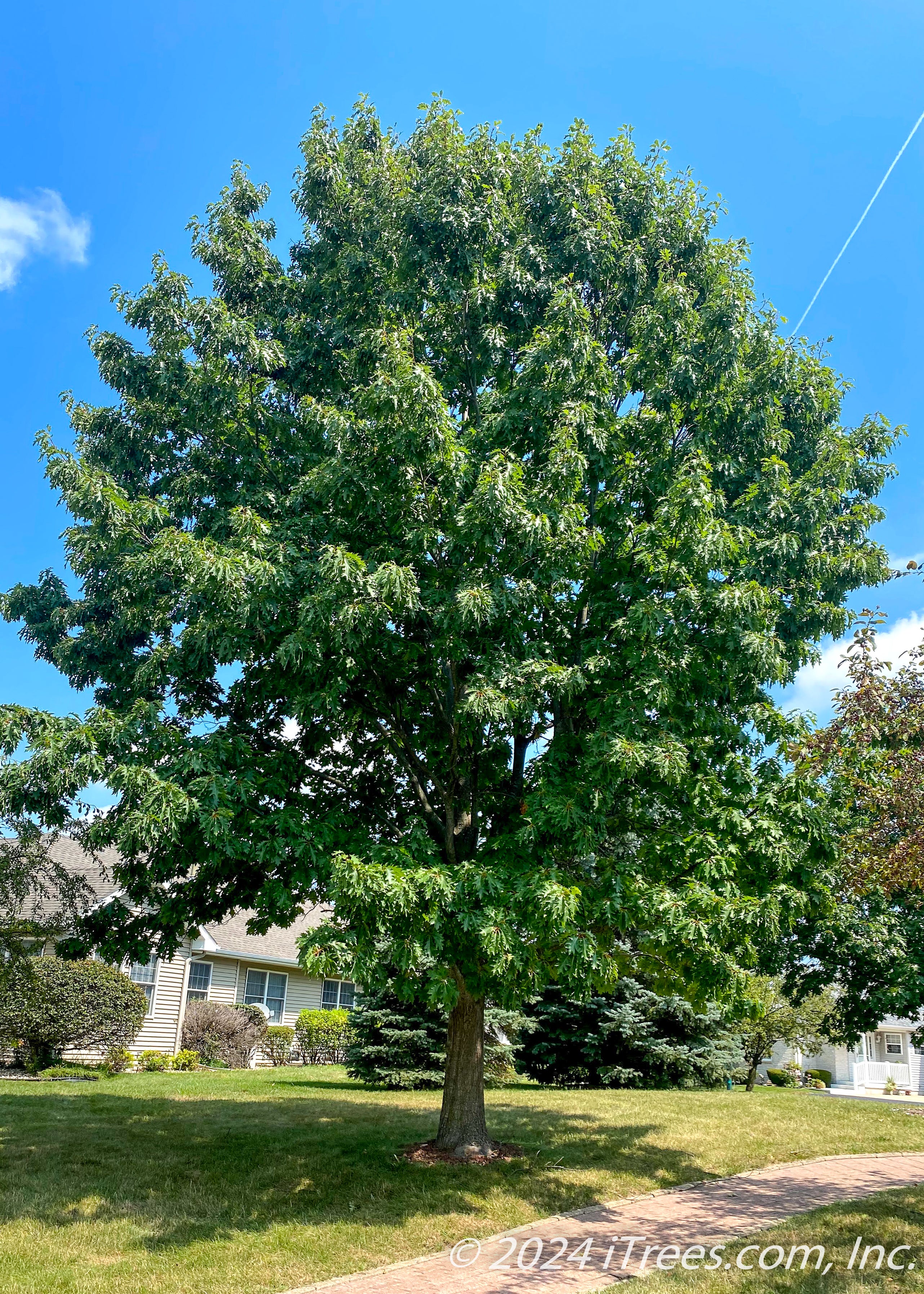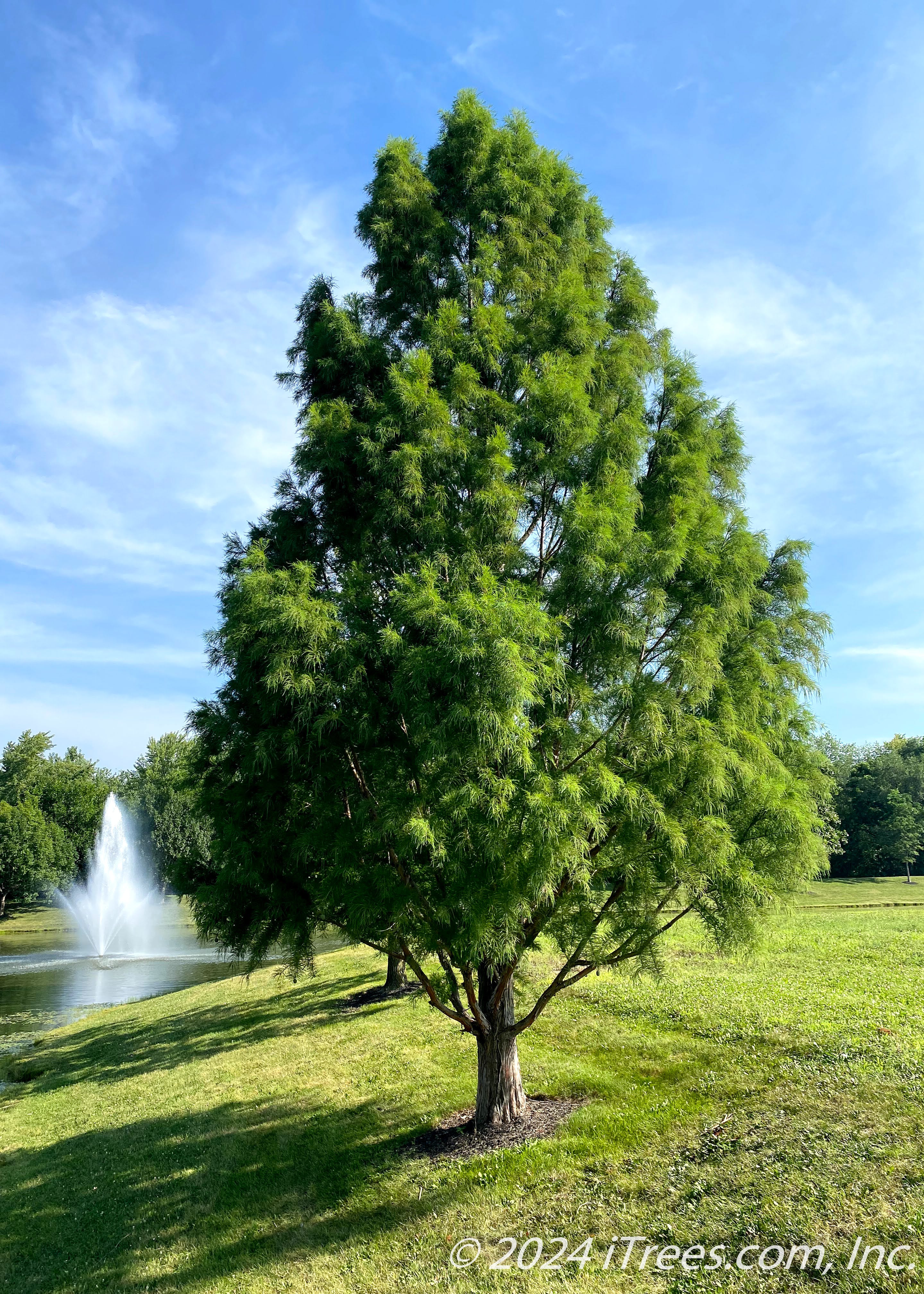
Oh, have we got a hot topic for you— Native Trees! Natives are often discussed in the green industry; however, they are a rare topic among customers looking to plant a tree in their yard. So, homeowners, this post is for YOU!
First and foremost, what is a native tree?
Definition of Native Trees → Native trees occur naturally in a particular region, ecosystem, or habitat. They have evolved over thousands of years to be part of the local environment. In Illinois, native trees support local wildlife and contribute positively to the ecosystem.
Simply put, native means it’s from here, and it’s supposed to be here. Native trees are found naturally in Illinois and support local ecology in small and BIG ways. When planted, they help boost wildlife ecology and do some pretty important things for the environment. They provide shelter for wildlife, supply food for animals and humans alike, and are crucial for attracting pollinators such as birds, bees, and butterflies.
Native trees hold great value not only for your home landscape but to your local neighborhoods and communities.
In our humble opinion, native trees are often underused in residential areas. However, when focusing only on new exciting cultivars and hybrids (which certainly have their place), we are doing a great disservice to the native species available. At the very least, they are worthy of consideration for your landscaping project.
![]()
Here are Our Top Illinois Native Trees for Your Home →
Native Ornamental & Flowering Options
Planting a native ornamental tree in the landscape offers numerous benefits that enhance both the aesthetic and ecological value of your garden.
Native ornamental & flowering trees are well-adapted to the local climate and soil conditions, which means they require less maintenance and are more resilient to pests and diseases. This adaptability leads to healthier growth and reduces the need for chemical treatments, making them an environmentally friendly choice.
Incorporating these trees into your landscape can help anchor landscape beds by providing a focal point that draws the eye and creates a sense of balance and structure. When used as understory trees, they complement larger shade trees by filling out the canopy layers, promoting biodiversity, and offering habitats for local wildlife.
Additionally, native ornamental trees can serve as stunning stand-alone accents, with their unique shapes and vibrant flowers adding visual interest and seasonal color to any garden. Their blooming periods often coincide with local pollinator activity, supporting bees, butterflies, and other beneficial insects that contribute to the health of the ecosystem.
This tree, native to parts of the eastern United States, including Illinois, is celebrated for its stunning pink flowers that bloom in early spring. Its ornamental appeal makes it a popular choice for landscape use. In gardens and parks, it serves as a striking focal point with its vibrant blossoms that provide a burst of color after the long winter months. Its moderate size makes it suitable for urban environments, where it can be planted along streets or in smaller yards without overwhelming the space. Additionally, the tree's attractive foliage and graceful branching structure add visual interest throughout the year, making it a versatile addition to any landscape design. Its flowers also attract pollinators, such as bees and butterflies, enhancing the ecological value of the area. Overall, this tree is a favored choice for creating picturesque landscapes that blend beauty and function.
River Birch, with its natural habitat along riverbanks, is a versatile tree widely used in landscape design, especially in the eastern U.S., including Illinois. Its distinctive, peeling bark provides year-round visual interest, making it a popular choice for ornamental purposes. The tree's adaptability to various soil types and conditions, including wet and poorly drained areas, allows it to thrive in diverse landscapes. This makes River Birch an ideal candidate for planting in areas prone to erosion or waterlogging, where it helps stabilize the soil and manage stormwater. Additionally, its lush foliage offers shade and creates a natural habitat for wildlife, enhancing biodiversity in landscape settings. Whether used as a standalone specimen, in group plantings, or as part of a larger landscape composition, River Birch brings both aesthetic value and practical benefits to any outdoor space.
Native to the southeastern United States, American Yellowwood is highly valued in landscaping for its fragrant, white flowers that fill the air with a delightful aroma, creating a welcoming and serene atmosphere. Additionally, the tree's blossoms attract pollinators such as bees and butterflies, supporting local ecosystems and promoting biodiversity. Its lush, green foliage provides an attractive backdrop throughout the growing season, enhancing the visual appeal of any garden or public space. Furthermore, the tree is relatively low-maintenance, making it an excellent choice for both amateur gardeners and professional landscapers. It has also been found growing in Illinois, where it not only adds beauty and charm to gardens and public spaces but also contributes to environmental sustainability by improving air quality and providing shade, which can help reduce urban heat. The tree's adaptability to various soil types and climates makes it a versatile option for a wide range of landscaping projects.
Native to the northern U.S., including Illinois, this tree not only features horizontal branching and attractive flowers but also offers numerous landscape benefits. Its horizontal branches provide a unique architectural element, adding visual interest and structure to gardens and parks. The tree's attractive flowers bloom in clusters, creating a stunning display that attracts pollinators like bees and butterflies, contributing to local biodiversity. Additionally, its foliage offers a lush, green canopy in the spring and summer, and often transforms into vibrant shades of red or yellow in the fall, enhancing seasonal beauty. Its adaptability to various soil types and resistance to harsh weather conditions make it a resilient choice for enhancing both residential and public landscapes.
Native to the eastern U.S., including parts of Illinois, boasts a striking landscape presence with its clusters of delicate white flowers that bloom in the spring. These blossoms create a soft, ethereal canopy that brightens any garden or park setting. As the seasons transition to fall, the tree becomes even more captivating, sporting vibrant red berries that contrast beautifully with its lush transitioning foliage. This not only enhances the visual appeal but also provides a lively habitat for birds, making it a dynamic focal point in the landscape. Its ability to thrive in various soil types and its moderate size make it a versatile addition to any outdoor space, offering year-round interest and ecological benefits.
Found in the eastern United States, including Illinois, this small but mighty tree is often used for ornamental purposes and is loved for its flaming hot fall color. Beyond its vibrant appearance, it offers several landscape benefits. Its compact size makes it ideal for smaller gardens or urban settings where space is limited. The tree provides excellent shade during the hotter months, creating a cool, inviting environment. It also contributes to soil stability and erosion control with its root system. Additionally, the tree attracts a variety of wildlife, supporting local biodiversity. Its resilience to different soil types and adaptability to various conditions make it a low-maintenance choice for landscapers and gardeners alike.
Native Shade Trees
Native shade trees offer a multitude of benefits when incorporated into residential landscapes. These magnificent giants are not just visually appealing; they play a crucial role in supporting local ecosystems by providing habitats for various forms of wildlife, from birds to insects. Their presence enhances the natural beauty of a barren landscape, transforming it into a lush, inviting environment. Moreover, they contribute to the privacy of homes, particularly for second-story residences, by creating a natural barrier with their broad canopies.
Native shade trees offer more than aesthetic and ecological benefits. Their sturdy branches provide a natural playground for children, encouraging outdoor play and exploration. Additionally, native shade trees serve as living storytellers, witnessing and becoming part of the memories created in the spaces they adorn.
From a practical perspective, these trees are an investment in energy efficiency. Strategically planting them on the east, west, or northwest sides of a home can lead to significant reductions in heating and cooling costs. By providing shade during the hottest parts of the day, they reduce the need for air conditioning, ultimately leading to substantial savings on energy bills.
It's important to note that most native shade trees will grow to be quite large, so adequate space is essential for their full development. By allowing them the room to expand, homeowners can ensure that these trees reach their full potential, offering shade and beauty for generations to come.
Native to the central U.S., including Illinois, Northern Catalpa is celebrated for its striking HUGE heart-shaped leaves and late spring flowers. Its large leaves create a lush, tropical feel, making it an ideal choice for adding texture and depth to landscapes. The showy panicles of orchid-like flowers add a dramatic flair, serving as a captivating focal point in any outdoor space. These flowers not only attract attention with their beauty but also serve as a magnet for pollinators, enhancing the biodiversity of the garden. Whether used as a standalone accent or as part of a mixed border, this tree thrives in a variety of settings, from residential landscapes to public parks, offering both visual appeal and ecological benefits.
Native Hackberry is indeed native to Illinois. This native beauty significantly enhances residential landscapes with its tough-as-nails adaptability and ecological benefits. Its resilience makes it an ideal choice for homeowners seeking a low-maintenance addition to their garden, capable of thriving in diverse soil conditions and weather extremes. Its ability to support a variety of wildlife species contributes to a thriving ecosystem right in your backyard. Birds, insects, and small mammals are often attracted to this tree, fostering biodiversity and creating an engaging, dynamic environment. Its presence not only adds aesthetic appeal with its natural beauty and seasonal changes but also ensures a healthier, more balanced habitat that enriches the overall quality of the residential landscape.
Native to the Midwest, including Illinois. Kentucky Coffee Tree’s tropical appearance is characterized by lush foliage and rough bark, adding an element of intrigue to residential landscapes or parks. The dappled shade it provides creates a serene and inviting environment, perfect for relaxation and enjoyment of outdoor spaces. Its large stature not only makes it a striking focal point in the landscape but also offers practical benefits, such as acting as a natural canopy that can shelter smaller plants and wildlife. This combination of aesthetic and functional qualities makes it a cherished addition to the Midwestern landscape.
Native to the eastern United States, which includes Illinois. It is valued for its hardwood, often used for tool handles and fence posts, and it is known for its adaptability to various soil types. In residential landscaping, the American Hophornbeam is appreciated for its ornamental appeal, featuring delicate, birch-like leaves and a graceful, rounded canopy. Its modest size makes it an excellent choice for urban gardens and parks, providing shade and enhancing biodiversity. The tree’s resilience to drought and resistance to pests and diseases also make it a low-maintenance option, ideal for naturalizing areas and adding structure to mixed plantings.
Though more common in northern regions, Quaking Aspen can be found in parts of Illinois. It’s known for its trembling leaves and chalky white bark. This tree is a true standout in any landscape, adding a touch of elegance and uniqueness. Its bark, with its striking white hue, creates a dramatic contrast against the surrounding greenery, making it a focal point in gardens and parks. In the fall, its yellow-gold foliage transforms the tree into a breathtaking spectacle, as its vibrant colors light up the landscape. The fluttering leaves create a dynamic and lively visual effect, providing movement and texture that enhance the overall aesthetic of any outdoor space. This tree’s ability to adapt to different environments and its stunning seasonal transformations make it a valuable addition to any landscape design.
Shingle Oak, native to the eastern U.S., including parts of Illinois, offers several benefits for residential landscapes. Its unique oblong, smooth-edged leaves add distinct visual interest, while its adaptability makes it suitable for various soil types and conditions. This versatility allows it to be effectively used in diverse settings, from spacious backyards to parks and naturalized areas. In the fall, the leaves undergo a stunning transformation, displaying vibrant shades from rusty orange to deep crimson red. This seasonal display can create a striking focal point or beautifully complement other autumnal plants, enhancing the overall aesthetic of the landscape.
While often associated with southern swamps, this tree finds a welcoming habitat in the wet areas of Illinois, making it a unique and valuable addition to residential landscapes. Its striking bark and feathery foliage not only provide a distinctive aesthetic but also serve practical purposes. The tree's ability to thrive in damp soil conditions makes it an ideal option for areas prone to flooding or poor drainage, where other plants might struggle. Its towering presence and graceful branches can create a natural focal point in gardens, enhancing the overall architectural design of the space. Bald Cypress offers a tranquil, serene environment that can attract birds and other wildlife, adding life and movement to the landscape. As a versatile component of landscape design, it can be used as a standalone specimen or as part of a mixed border, complementing other plants with its unique texture and color. Whether lining a water feature or standing majestically in an open yard, this tree contributes significantly to the beauty and functionality of residential landscapes.
White Oak, the state tree of Illinois, is highly valued not only for its strength and longevity but also for its notable landscape contributions. Its majestic presence and broad canopy provide ample shade, making it an ideal choice for large open spaces such as parks, estates, and campuses. In residential settings, it can serve as a stunning focal point in spacious backyards or along property boundaries, where its expansive shade can cool outdoor areas and reduce energy costs by shielding homes from the sun.
Its vibrant foliage introduces seasonal interest, transitioning from lush green in spring and summer to brilliant yellows and reds in the fall, making it a captivating addition to any landscape. This dynamic color display can complement other plantings, enhancing the overall aesthetic of landscapes and public spaces.
White Oak plays a critical role in enhancing biodiversity. It can be strategically placed in naturalized areas or along the edges of woodlands to provide habitat and food for various wildlife, including birds and small mammals. In urban landscapes, it can be planted along streets or in community parks to create green corridors that support local ecosystems.
White Oak's versatility and ecological benefits make it an essential component of both urban and natural landscapes, offering beauty, shade, and a haven for wildlife.
Swamp White Oak is an excellent choice for residential landscapes, especially in areas where the soil tends to be poorly drained or where other trees might struggle to thrive. Its adaptability to wet conditions makes it particularly valuable in regions prone to flooding or those with heavy, clay-based soils. When strategically placed in a yard, it can provide significant shade due to its broad, spreading canopy, making it perfect for creating a cool, inviting outdoor space during hot summer months. Additionally, its attractive, peeling bark and rich, green foliage add visual interest throughout the year. In the fall, the leaves turn a stunning golden brown, providing a burst of color. It's also a beneficial habitat for wildlife, supporting various bird species and insects. When incorporating Swamp White Oak into a residential landscape, consider situating it in low-lying areas where water tends to gather, ensuring it has enough space to grow to its mature size without interfering with structures or other plants.
Native to the Midwest, including Illinois, Bur Oak is a hardy tree renowned for its massive size and resilience. In residential landscapes, this tree offers numerous benefits. Its sprawling canopy provides ample shade, making outdoor spaces more comfortable during hot summer months. This can lead to reduced energy costs by naturally cooling nearby homes. Additionally, Bur Oak is highly adaptable to different soil types and environmental conditions, making it a reliable choice for a variety of landscape settings. Its deep root system helps to prevent soil erosion, contributing to the stability and health of the landscape. Bur Oak supports local wildlife, providing habitat and food for birds and small mammals, and enhancing the biodiversity of residential areas. The tree's majestic appearance also adds significant aesthetic value, creating a focal point in any landscape or yard.
Often referred to as Tulip Poplar, this tree is a remarkable addition to any landscape, celebrated for its large mature size and seasonal beauty. This tree is native to the eastern United States, including Illinois, and is renowned for its striking tulip-like flowers, which bloom in late spring. These flowers, typically a vibrant yellow-green with an orange band at the base, add a splash of color and a sense of whimsy to the landscape.
In terms of landscape value, the Tulip Tree is an excellent choice for creating a dramatic focal point due to its tall, straight trunk and broad, symmetrical canopy. Its large, uniquely shaped leaves turn a brilliant golden-yellow in the fall, providing a stunning display of seasonal color change.
Additionally, the tree's rapid growth rate and ability to reach impressive heights make it ideal for providing shade and enhancing the vertical dimension of landscapes or parks.
When considering where to plant a Tulip Tree in the landscape, it is important to choose a location with ample space for the tree to reach its full potential. It thrives best in well-drained, slightly acidic to neutral soil, and prefers full sun exposure to ensure optimal growth and flowering. Due to its size, it is commonly planted in large yards, parks, or as a street tree, where it has room to expand without interfering with structures or power lines. Planting it in a location where its shade can benefit outdoor living areas or where its flowers can be easily admired will maximize its landscape value.
Chinkapin Oak is highly regarded for its landscape value due to its adaptability to various soil conditions and its natural landscape appeal. This deciduous tree can thrive in well-drained soils and is tolerant of both alkaline and drought-prone environments, making it an excellent choice for many landscapes in the Midwest, including Illinois. Its attractive, glossy green leaves turn to a rich yellow to deep red in the fall with its color varying depending on weather season to season. This tree provides significant seasonal interest and color throughout spring, summer, and fall. Additionally, Chinkapin Oak produces small, sweet acorns that attract wildlife, such as birds and squirrels, adding to the ecological value of any garden or yard.
When considering placement around a home, the Chinkapin Oak is best situated in locations where it can receive full sunlight, as this promotes healthy growth and optimal acorn production. It is ideal for planting in large yards, as it can grow to a substantial size, reaching heights of 40 to 60 feet with a similar spread. Planting this tree as an accent in the front yard can create a striking focal point while placing it in the backyard can provide shade and a natural habitat for wildlife. It is also a good choice for lining driveways or property lines, where its symmetrical shape can enhance the landscape design. Be sure there is adequate space away from structures and power lines to accommodate its mature size.
Native Evergreen Trees
Planting a native evergreen tree in your home's landscape offers an array of benefits that extend beyond their mere beauty. These trees, adapted to the local climate and soil conditions, require less maintenance and are more resilient to pests and diseases, making them a sustainable choice for any Illinois landscape.
One of the primary advantages of native evergreens is their ability to serve as natural windbreaks. By strategically placing these trees, you can significantly reduce wind speed around your home, which can help lower heating costs in winter and protect more delicate plants in your landscape.
Native evergreens provide essential habitats for local wildlife. Their dense canopies offer a safe haven for birds and small mammals, contributing to biodiversity and creating a lively, dynamic ecosystem right in your backyard. This can be particularly beneficial for bird watchers and nature enthusiasts, as these trees will attract a variety of species throughout the year.
In addition to ecological benefits, native evergreens contribute to the aesthetics and functionality of your landscape. They maintain their foliage year-round, providing continuous privacy and screening for your home. Their ability to offer shade during the hot summer months can also make outdoor spaces more enjoyable and reduce cooling costs.
Lastly, the enduring beauty of native evergreens adds visual interest to your landscape, with their varied shapes, textures, and shades of green creating a stunning backdrop that enhances the overall appeal of your property.
These native trees hold significant landscape value due to their majestic appearance and versatile functionality. Eastern White Pine are towering evergreens, reaching heights of 50 feet, creating a striking visual impact, making them ideal focal points in large yards or naturalistic landscapes. Their soft, flexible needles and layered branches contribute to a lush, textured backdrop that enhances the beauty of surrounding plantings.
When it comes to placement around a home, White Pine trees serve multiple purposes. For optimal benefits, consider planting them at the northern or western edges of your property. This strategic positioning not only maximizes their ability to act as windbreaks—shielding your home from harsh winter winds—but also provides shade during the hot summer months, potentially reducing cooling costs.
Additionally, White Pine can be used to create a natural privacy screen. Their dense canopy offers year-round seclusion from neighbors or busy streets, fostering a sense of tranquility in your outdoor living spaces. For those living near water, these trees are particularly valuable, as they offer habitat for wildlife, including American Bald Eagles, enhancing the ecological diversity of your landscape.
White Pine is not just a tree; it’s a multifaceted asset to your property, providing aesthetic appeal, environmental benefits, and practical solutions for privacy and weather protection.
![]()
Embrace Native Trees for Your Landscape
By incorporating a native tree into your landscape, you’ll not only add a touch of life back to the environment but also enhance the beauty of your home. This is a worthwhile investment that you can truly feel good about!
To recap... The Benefits of Native Trees →
Support Local Ecosystems: Native trees play a crucial role in providing habitat for wildlife.
Environmental Advantages: They offer benefits such as energy savings and improved air quality.
In addition, selecting native species aids in preserving local flora, ensuring the protection of the region's natural heritage and biodiversity. Planting native trees enhances your landscape with beauty, sustainability, and ecological balance. By opting for native species, you create a landscape that reflects the natural splendor of the area, fostering a deeper connection with your local environment.


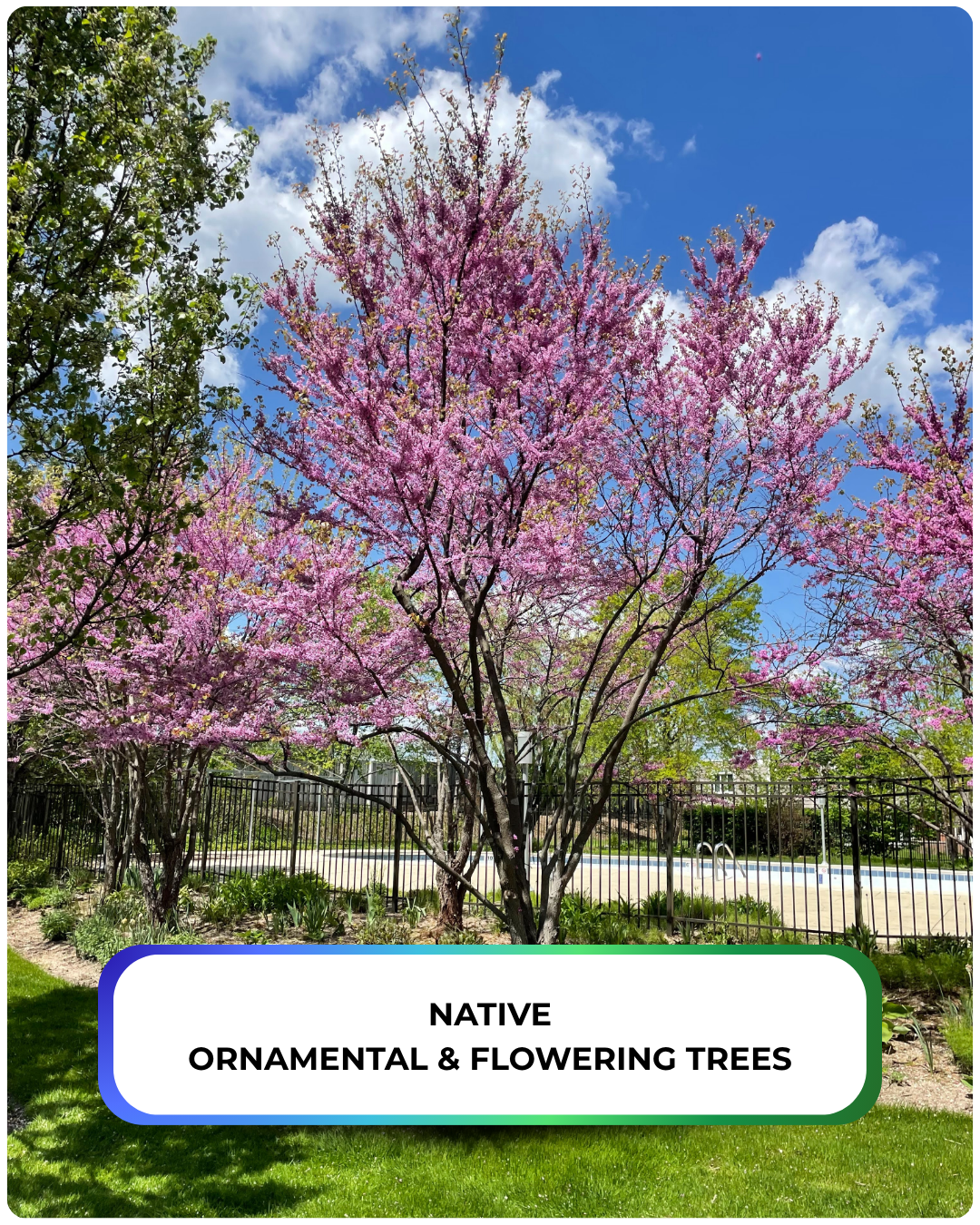
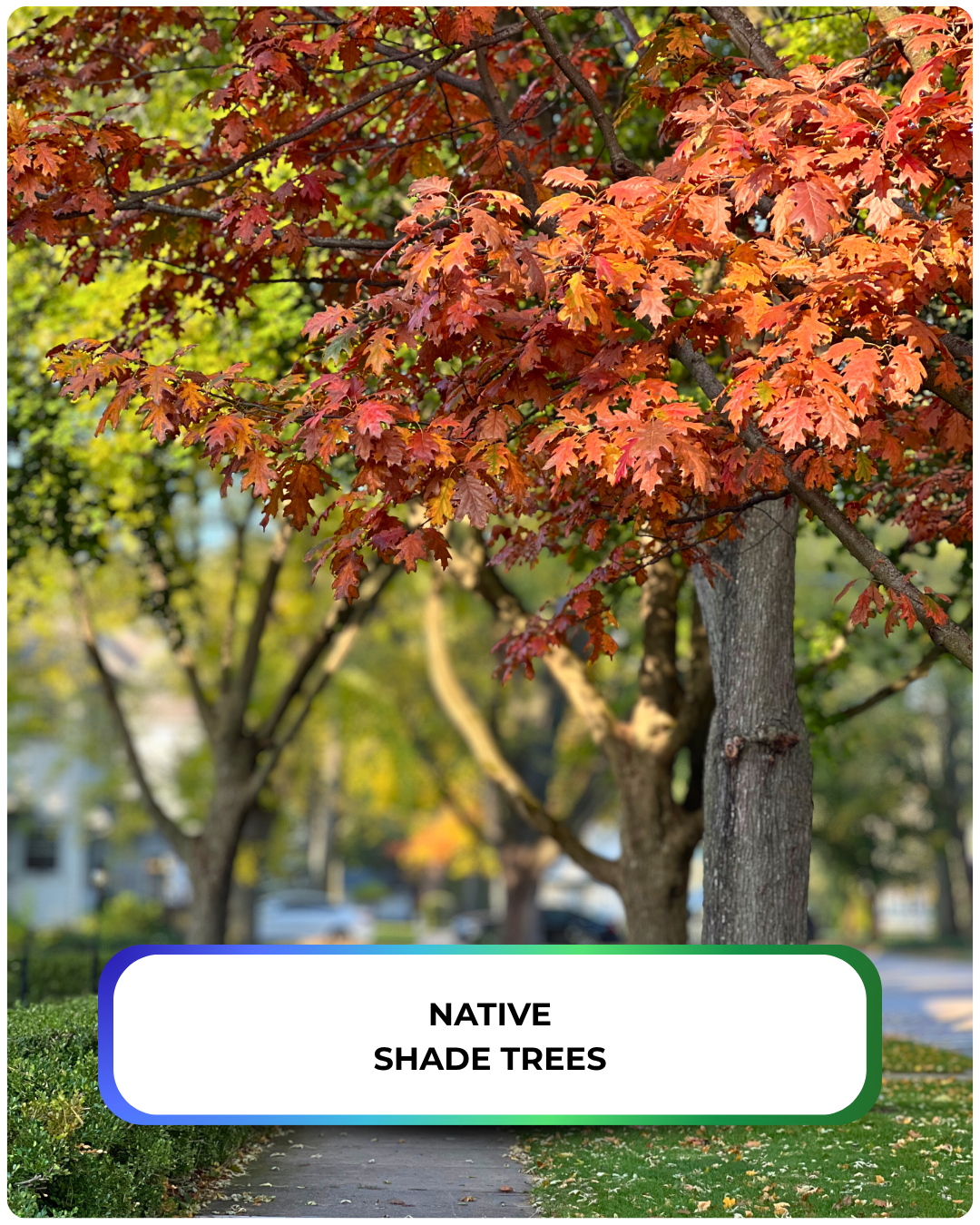
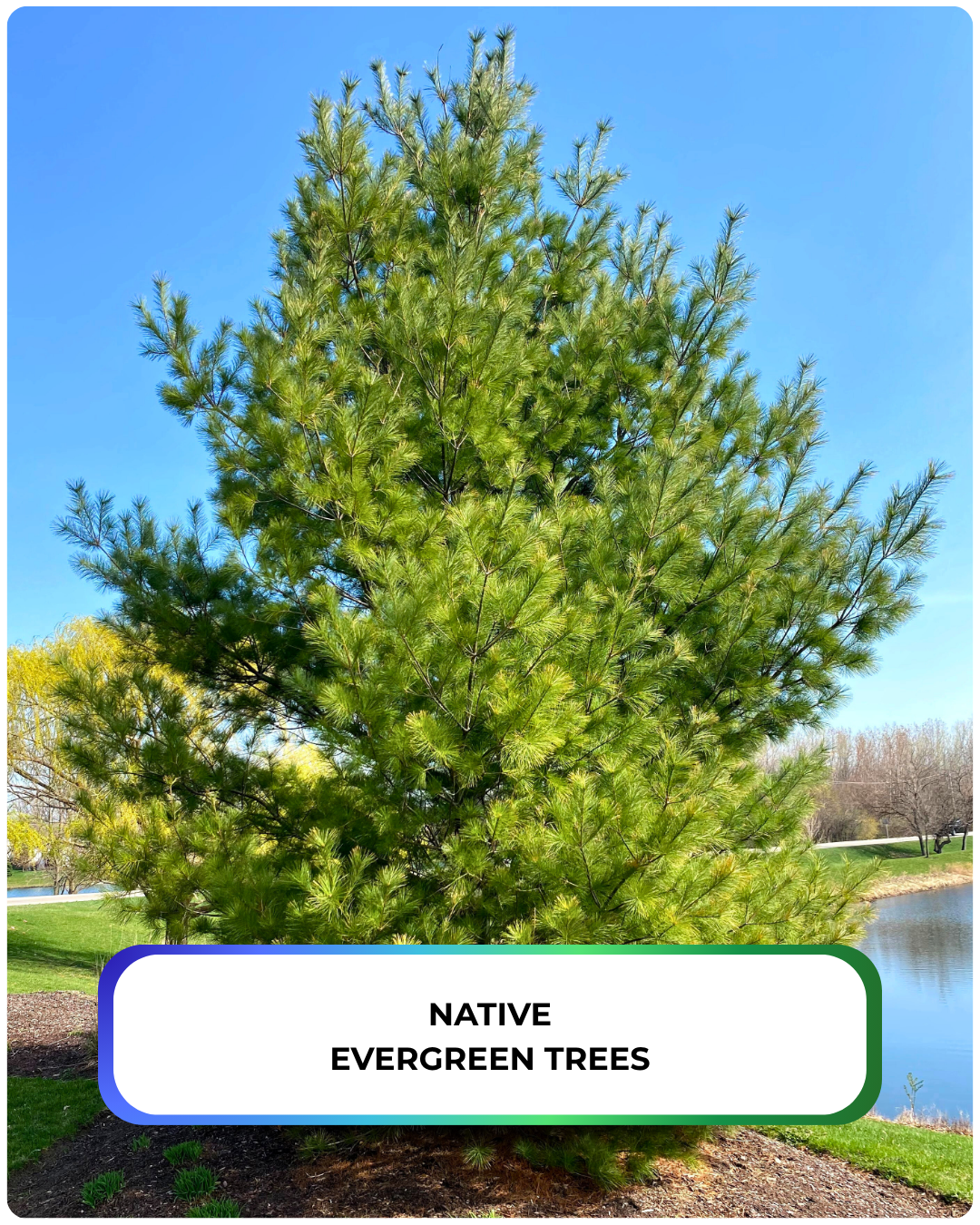



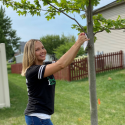
.png)

.png)


